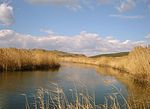Çandarlı Castle
Castles in TurkeyDikili DistrictTourist attractions in İzmirTurkish castle stubs

Çandarlı Castle, (Turkish: Çandarlı Kalesi) is the castle in the Çandarlı District of the Dikili district of İzmir. The exact year it was built is unknown, and it was restored by the Genoese in the 14th century. It was rebuilt in the 15th century by order of Grand Vizier Çandarlı Halil Pasha. The last restoration work started in 2009 was completed in 2014. UNESCO added the castle to the World Heritage Tentative List in 2013.
Excerpt from the Wikipedia article Çandarlı Castle (License: CC BY-SA 3.0, Authors, Images).Çandarlı Castle
Kale Sokak,
Geographical coordinates (GPS) Address External links Nearby Places Show on map
Geographical coordinates (GPS)
| Latitude | Longitude |
|---|---|
| N 38.9338 ° | E 26.9337 ° |
Address
Çandarlı Kalesi
Kale Sokak
35980 (Çandarlı Mahallesi)
Turkey
Open on Google Maps

